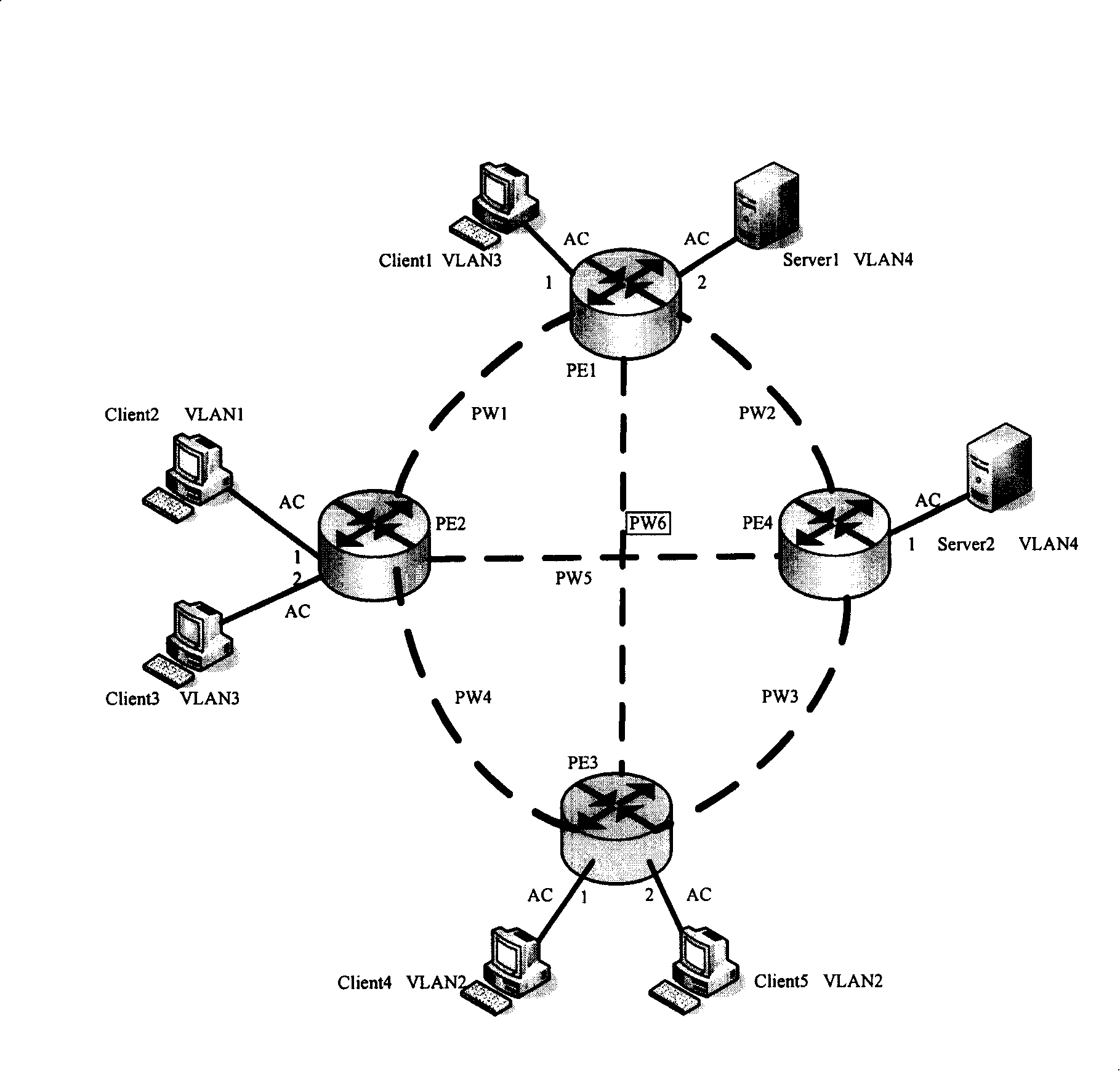User grouping intercommunication/isolation method and device in virtual special network service
A user grouping and isolation device technology, applied in the field of virtual private network services, can solve the problems of inability to distinguish VLANs, unable to truly play the role of VLANs, unable to use VLAN user grouping and isolation, etc., to achieve flexible access control policies, simple configuration, Feature-rich and easy-to-use effects
- Summary
- Abstract
- Description
- Claims
- Application Information
AI Technical Summary
Problems solved by technology
Method used
Image
Examples
example 1
[0036] Realize the intercommunication between two different VLANs on different PEs (taking the intercommunication between Client2 and Server1 as an example).
[0037] First describe the arp request and the MAC address learning process: Client2 needs to access Server1, first Client2 sends an arp broadcast message, and the message forwarding module 106 on PE2 finds that there is no forwarding table entry corresponding to the source MAC+VLAN of the message in the forwarding table , just send the information such as the source MAC address in this message and VLAN and incoming interface to MAC address learning and FIB management module 104, MAC address learning and FIB management module 104 learn according to the information sent on the message forwarding module 106 The outgoing interface corresponding to VLAN1+MAC2 is 1, and the generated forwarding entry is recorded as VLAN1+MAC2--1, and then search the VLAN intercommunication relationship table, find out that there is a VLAN inte...
example 2
[0047] Realize the isolation between different VLANs on different PEs (take the realization of the isolation of Client2 and Client1 as an example to illustrate).
[0048] Client2 tries to access Client1. First, it sends an arp request message. The VLAN carried in the message is VLAN1. This message is a broadcast message, so it will be broadcast to PE1 through PW1. For PE1, the message is received from PW. Therefore, the message forwarding module 106 on PE1 broadcasts the message to the local VPN member that is the same as the VLAN in the message and the local VLAN that has an intercommunication relationship with this VLAN. There is no VLAN1 member locally, only VLAN4 and VLAN1 There is an intercommunication relationship, so the message will be broadcast to VLAN4, that is, only Server1 can receive the message, Client1 cannot receive the message, and Client1 cannot reply to the arp request, so the arp request of Client2 fails and cannot communicate with Client1 sends packets to ...
example 3
[0051] Implement isolation between different VLANs on the same PE (take the isolation of Client2 and Client3 as an example to illustrate).
[0052] The arp request message of Client2 arrives at PE2. For PE2, the message is a broadcast message received from the local AC. The message forwarding module 106 on PE2 forwards the message to the local VPN members and VPN local members of the VLAN with intercommunication relationship and all PW broadcasts, there are no other members of VLAN1 except Client2, and there is no member of VLAN4 with intercommunication relationship with VLAN1, so Client3 cannot receive the arp request message, and Client2's The arp request failed, and the packet cannot be sent to Client3. Due to the same reason, the arp request of Client3 will also fail, and it cannot continue to send packets to Client2.
PUM
 Login to View More
Login to View More Abstract
Description
Claims
Application Information
 Login to View More
Login to View More - R&D
- Intellectual Property
- Life Sciences
- Materials
- Tech Scout
- Unparalleled Data Quality
- Higher Quality Content
- 60% Fewer Hallucinations
Browse by: Latest US Patents, China's latest patents, Technical Efficacy Thesaurus, Application Domain, Technology Topic, Popular Technical Reports.
© 2025 PatSnap. All rights reserved.Legal|Privacy policy|Modern Slavery Act Transparency Statement|Sitemap|About US| Contact US: help@patsnap.com


